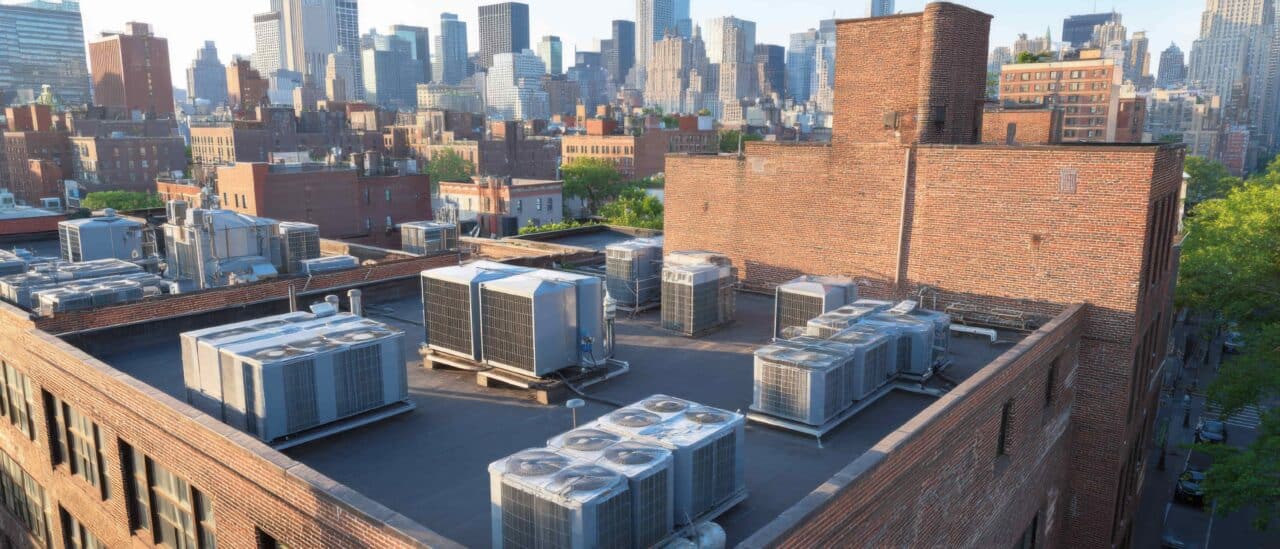A commercial HVAC warranty is a manufacturer- or contractor-backed guarantee that covers
specific repairs or part replacements on Heating, Ventilation, and Air Conditioning (HVAC)
systems when certain conditions are met. For facility managers and building owners, it’s one of
the few tools available to reduce financial risk on six-figure systems that are essential to
everyday operations.
Since 1944, we’ve helped Southeast facilities protect HVAC investments through smart design,
licensed maintenance, and proactive warranty management.
This article breaks down how to activate, protect, and maximize your HVAC warranty coverage,
so you don’t lose out when it matters most.
Key Components of a Commercial HVAC Warranty
At a high level, every commercial HVAC warranty includes a few core elements:
- How and when coverage begins
- What’s actually protected
- What voids the coverage
- How long coverage lasts
Understanding each of these terms is critical because even minor oversights can cost your
facility tens of thousands in repairs. Plus, when HVAC systems fail unexpectedly, they add to a
larger problem: Unplanned downtime, which averages $103,000 per hour in lost productivity and
revenue.
Keeping your warranty active and enforceable may mean more paperwork, but it’s a frontline
defense against those financial hits and helps you maximize building uptime.
These are the four components of an HVAC warranty that every facility team needs to manage.
Registration & Activation
Most warranties are only valid if registered within 30 to 90 days of installation. Miss that window,
and you’re often left with zero manufacturer coverage, regardless of the equipment’s age.
To activate your warranty, you’ll need:
- Equipment serial numbers
- Proof of installation
- Contractor and project details
Manufacturers set aside 0.92% of product revenue to cover future warranty claims. That means
they count on customers making a claim, but only for registered units that meet their criteria.
Coverage Scope
HVAC warranties usually cover:
- Compressors
- Coils
- Fans and motors
- Control boards
Labor coverage varies. Some OEMs offer it, others don’t.
Consumables (filters, belts), cosmetic issues, and weather-related damage are almost always
excluded.
Check both the manufacturer’s policy and the contractor’s contract. Terms vary more than you
think.
Exclusions & Fine Print
The exclusions and fine print are where most warranties fall apart. Common mistakes that void
coverage include:
- Improper installation or start-up
- Skipped preventive maintenance
- Using non-OEM parts
- Repairs by unqualified technicians
The industry’s warranty claim rate is just 0.78%, meaning most claims are denied or never filed.
So, don’t assume coverage. Document everything.
Duration & Transferability
Standard HVAC warranties run 1-5 years for parts, and up to 10-12 years for compressors.
Extended warranties may be available, but must be purchased before the original term expires.
If your building is sold or a new owner takes over, make sure you verify:
- Transfer conditions
- Required documentation
- Deadlines to file the transfer
Failing to do so often resets coverage to zero.
Best Practices to Protect and Extend HVAC Warranty Coverage
To maintain an active and valid commercial HVAC warranty, facility managers must meet a
clear set of requirements — none of which happen by accident.
Manufacturers lay out specific terms for:
- Maintenance
- Documentation
- Part usage
- Technician qualifications
If any of the terms above are skipped, the warranty can be voided, leaving you on the hook for
repair costs.
This section outlines the five most important practices for maintaining HVAC warranty coverage
and minimizing long-term risks to your system and budget.
Follow OEM Maintenance Schedules
Skipping preventative maintenance is the #1 reason warranty claims get denied. Every
manufacturer outlines a specific service timeline (often quarterly or biannually) to keep your
system operating within design limits.
Our licensed HVAC technicians follow OEM service intervals to the letter, including:
- Filter replacements
- Coil cleanings
- Refrigerant charge checks
- Electrical and control board inspections
Warranty coverage is your backup plan. Preventive HVAC maintenance gives you daily
protection and a 545% ROI by reducing failures and repair costs.
Keep Detailed Service Records & Invoices
When something goes wrong, you need more than a technician’s word. Warranty administrators
often request service logs, proof of routine care, and receipts for OEM parts.
That’s why every service from our team includes digital documentation: Timestamps, technician
credentials, service notes, and performance data.
If a claim is challenged, you have the evidence to back it up.
Use OEM‑Approved Parts & Qualified Technicians
Even a simple belt or capacitor swap can void your warranty if it’s not an approved part or if
someone without the proper credentials installs it.
We only use OEM-approved components and licensed, insured technicians trained to comply
with the manufacturer's terms across all major commercial systems.
Monitor Operating Conditions & Runtime Hours
Don’t wait for failure. Tracking system conditions (like load variation, heat exposure, or
excessive runtime) can surface issues while still under warranty.
Facilities that adopt predictive maintenance can cut costs by 8-12% compared to preventive
maintenance, and up to 40% over reactive models, according to GridPoint. Our Building
Intelligence tools can alert you before small shifts become claim-worthy events.
Purchase Extended Coverage Before Expiration
Facility managers, business owners, property managers … you’ve got a lot on your plate. Don’t
assume you’ll remember something like the deadline on your HVAC warranty.
Set reminders to review and extend your coverage before the original term ends.
Delayed action can get expensive fast. For every $1 in capital maintenance that gets deferred,
facility teams end up spending $4 down the line in emergency repairs, unplanned downtime,
and equipment that fails years ahead of schedule.
An active warranty helps offset those long-term costs, keeping you covered as your equipment
ages and giving you more control over capital planning.
Navigating Warranty Claims
Filing a commercial HVAC warranty claim requires a clear, step-by-step approach. You need to
confirm eligibility, gather specific documentation, work with approved service providers, and
make sure the repair process is fully recorded.
Any missed detail could slow the resolution, or worse, invalidate the claim.
Here’s how to handle the process efficiently from start to finish.
Confirm the Issue & Check Eligibility
First, make sure the equipment is powered down and safe to inspect. That means verifying
lockout/tagout procedures and de-energizing the unit fully.
Then check your building automation system or system logs for fault codes, alarms, or service
flags.
Compare the issue against your warranty documents. Was this component covered? Has the
system been maintained according to the required schedule? These questions will tell you if the
claim is worth pursuing.
Collect Documentation
- Your claim won’t move forward without the right paperwork. Start by gathering:
Model and serial numbers - Proof of warranty activation
- Maintenance logs and service invoices
If you’ve worked with our team in the past, this information is already recorded and accessible. If
not, you may need to dig through old contractor files or past work orders.
Contact the Manufacturer or Warranty Admin
Once you’ve confirmed eligibility, reach out to the correct contact. Depending on your system,
that could be the manufacturer directly, a distributor, or a third-party warranty administrator.
Many now offer online claim portals, which can speed up processing, especially for parts orders
or preliminary approvals.
Coordinate Repairs & Part Shipment
Warranties typically require that only authorized service providers handle repairs. If your claim
involves part replacement, timing matters. Any delay in paperwork or approval can push out
shipping windows.
Our technicians are licensed and familiar with OEM warranty workflows, which reduces friction
during this step.
Document Resolution
Once repairs are complete, update your facility’s asset management system with:
- Repair summaries
- Proof of OEM part use
- Any updated warranty records
These records are useful for internal audits, resale documentation, and future claims. If the
same issue arises again, you’ll have a trail of service notes ready to go.
Proactive Warranty Management in Action
Proactive warranty management means putting the right systems in place before something
fails, not scrambling to prove eligibility after the fact. That includes detailed service logs,
documented inspections, and maintenance that aligns with the original equipment
manufacturer’s terms.
We’ve seen this approach work best when facility teams treat warranty compliance as part of
their seasonal routines. For example, quarterly checks that include coil cleanings, refrigerant
charge validation, and control board inspections. Each of these improves performance and
preserves eligibility.
Our Seasonal Facility Maintenance Checklist was created to help teams formalize the process.
By turning OEM requirements into repeatable steps, facilities avoid missed deadlines, skipped
records, and claim denials down the line.
It’s also worth reviewing how your building tracks service history. Is it centralized and
searchable? If not, consider building that habit now because when the next failure hits, you'll
want a paper trail.
Partnering with Us for Warranty Protection
The benefits of partnering with a professional commercial HVAC contractor for warranty
protection come down to risk reduction, cost control, and operational confidence. Warranties are
protective tools, but only when maintained properly.
As this guide has shown, documentation and preventive service matter more than most facilities
realize. Extended coverage also requires action before deadlines pass.
Nearly 40% of total commercial energy use is attributed to your heating and air conditining. That
makes uptime and efficiency crucial for comfort and revenue continuity.
We bring 80 years of experience managing complex HVAC systems across healthcare,
government, and industrial sectors. Our licensed, insured, OEM-trained technicians know the
terms, the timelines, and how to keep your coverage intact.
We offer:
- 24/7 commercial HVAC service in Tennessee, Kentucky, Alabama, and Georgia
- Facilities Management and Maintenance Plans built for compliance and uptime
- Warranty-safe service for all major commercial HVAC brands
Let us protect your system and your bottom line. Request an appointment with our facilities
team today.
Protect your people and your production.
CALL US NOW AT 615.567.1000

